
Over the past 30 years, in collaboration with colleagues, I have developed an approach to supporting early learning that seeks to deepen our understanding of child development, the adult role and the impact our interactions and the nursery environment can have on young children.
Called Responding to Process, the approach takes as its starting point the cognitive and physical processes that are emerging in young children – principally self-regulation and executive function – and shows that it is through gentle, respectful and thoughtful responses to children that we can become great early years practitioners.
After many years supporting educators to develop their role, I have found that a deeper understanding of early learning and more effective support for children emerge when the educator is tuned into thinking about these emerging processes. The result is interactions that are much more powerful, precise, kind and truly supportive of young children.
The development of this approach is timely as there is growing evidence of the importance of self-regulation to early learning. That importance is now reflected in both the revised EYFS framework, with the introduction of an Early Learning Goal on Self-regulation, and in the revised EYFS guidance, which is due for release this month.
The approach can also guide us on how best to respond to children’s emotional and learning needs post-lockdown (see box).
FREEING THE EDUCATOR
Importantly, Responding to Process also frees educators from the current limitations of their role. It allows them to think more broadly about early learning and to focus on what really matters in supporting children’s early development.
In my experience, educators within the English schools system are often guided by the dominant pedagogy that the teacher is the source of information and the pupil is the empty vessel to receive it.
Child-led learning?
Of course, in early years, we have pedagogies to call upon that fiercely challenge that assumption. We seek to embed into our practice the wisdom of Loris Malaguzzi, Margaret Carr, Maria Montessori and Friedrich Froebel, which recognises children as natural learners, complete as they are, and that it is through self-directed play that they continue to learn, driven by their innate curiosity about the world.
We know about the ‘unique child’, ‘schemas’, ‘sustained shared thinking’ and Ofsted’s definition of teaching with all those possible interactions, such as ‘observing’, ‘encouraging’ and ‘facilitating’, to guide our practice. Yet, we only have to look a little closer at a ‘child-led approach’ to see that it is often child-led in name only.
Narrow and episodic learning
When the educator’s ‘tools’ are viewed only through the lens of testing and outcomes, activities to plan and deliver, facts to impart, questions to ask, experiences to give and key vocabulary to teach, the learning process becomes narrow and episodic. When an aspect of phonics, early maths or an indiscriminate assessment goal dominates an educator’s thinking, then the individual child becomes lost, and along with it, respect for who they are as a creative, independent learner.
Learning moment by moment
The value placed on learning during young children’s play should not lie in the results but in what is happening moment by moment during that play. This can easily be expressed by the phrase ‘process not product’ – something that early years educators really understand. But what do we mean by ‘process’ in the context of ‘Responding to Process’?
ESSENTIAL PROCESSES
The Responding to Process approach focuses on two kinds of process.
Cognitive processes
Specifically, the approach tunes into the development of the brain’s executive function, which depends upon the growth of:
- working memory
- mental flexibility
- self-regulation
The formation of these interconnected brain functions are the foundations upon which all other learning is based, leading to the development of language and creativity and the ability to control thoughts and emotions. They are, therefore, vital to survival and future happiness.
Our executive function is not fully developed until our mid-twenties, but it is in the early years of life that the fastest and most life-impacting brain development takes place.
Physical processes
The second focus within the approach is the development of the vestibular system. This sensory system is responsible for our sense of balance and spatial awareness and is vital in the development of our gross and fine motor skills.
A shift in mindset
We are not neuroscientists or occupational therapists. However, by keeping the importance of these life-impacting processes uppermost in our minds as we interact with young children and develop our environments, we can change our mindsets as educators.
It is a subtle shift, but it is enough to make a significant impact on practice and, consequently, outcomes for young children. With this approach, the educator’s responses become more sensitive and powerful.
But remember…
When adopting the Responding to Process approach, it is crucial to bear in mind that the development of these processes is:
- interconnected
- individual to each child, so children develop them at different rates
- not linear, where an aspect of development is ticked off as being ‘achieved’ before moving onto the next one
- dependent on the quality of opportunities that children engage in to strengthen and expand these vital skills.
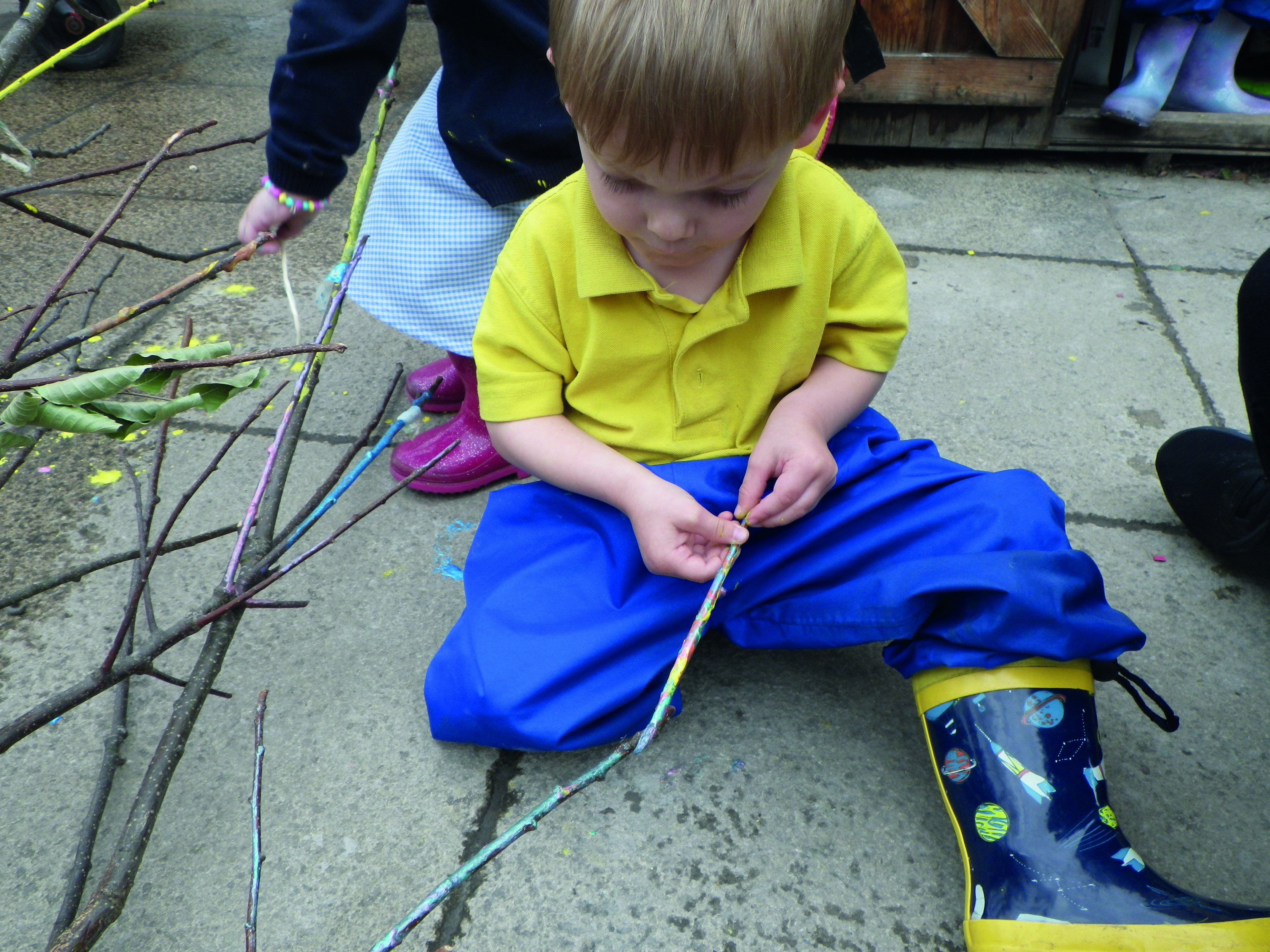
RESPONDING TO PROCESS: IN ACTION
In the following examples of Responding to Process in action, the word ‘response’ is used when referring to interactions, because it implies thought and perception on behalf of the educator. The educator’s ‘response’ could be highly interactive, involving lots of talking and activity, or simple, restrained and calm.
- The educator’s responses are highlighted in bold, and
- Words related to the processes are in italics.
CASE STUDY: Maximus
Unseen, the educator observed Maximus looking intently at the photographs from the previous day’s learning. He had moved a stool closer to the screen to watch them more comfortably.
The photographs included shots of him painting the branch of a fallen tree in the garden. He was still, focusing on the images and sometimes smiling. The educator watched, wondering to herselfwhat he was thinking:
- Was he recalling what he did the previous day, so developing his working memory?
- Were the photographs showing him that he is valued by educators, so helping him to develop an understanding of himself, his relationships, his environment and the connections between them?
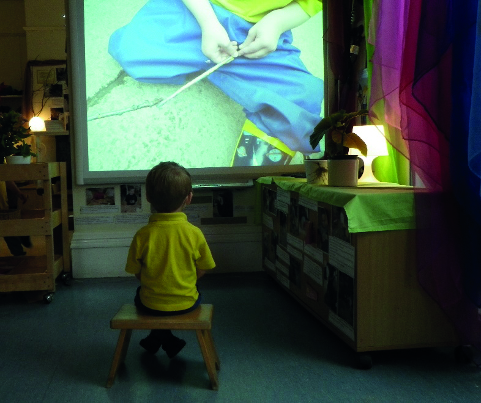
The educator continued to observe and be curious about his interest and reaction. Her observations were informed by conversations with his family and fellow educators, previous interactions and documentation; she had a good understanding of his current development.
She was also aware that he is often quiet at nursery and that his mother was concerned about his making friends.
The educator joined Maximus at the screen, smiling at him, looking with interest at the image, showing genuine curiosity and mirroring his joy at seeing himself in the photo. ‘Rainbow tree,’ he said. She nodded and smiled, repeating Maximus’s language and modelling a bit more. ‘Paintingthe rainbow tree?’ she asked. Maximus nodded.
To facilitate, she paused at another photograph of Maximus. Together, they studied the photograph, with the educator trying to create a collaborative atmosphere; a relationship that encouraged thinking, respect and communication and language.
She waited as she could see he was concentrating. Looking puzzled, he finally said, ‘My welly!?’ She nodded and said, ‘Yes, your welly!?’
She waited and wondered what he was thinking. Maximus then shrugged and pointed to his feet. The educator realised that he knew he had two legs but, in the photograph, he had only one!
The interaction showed how Maximus was developing memory and mental flexibility, as he was having to think about multiple conceptsand problem-solve.
The educator decided to comment, hopefully modelling language to reflect his thinking. She said, seriously(because Maximus was serious), ‘I wonder where your other welly has gone?’ Maximus nodded, pointed to his legs and held up two fingers.
The educator continued to support him to work out what had happened through modelling language, using gesture and observation. She knew that simply explaining the missing welly to him would not support his thinking or language development.
Outcomes for Maximus
- The educator was able to assess Maximus’s co-ordination and balance as he moved to and sat on the stool, and another educator had also noted his grip of a paintbrush the previous day. These observations can inform future interactions and possibilities for learning and supporting Maximus’s physical development.
- Maximus is starting to see things in multiple ways, which means that his mathematical understanding and language of position (under, behind, next to) can also develop.
- Maximus was supported in his interactions by his peers. He was interested in their talk and happy to share his own ideas, building relationships and connections and supporting his learning in personal, social and emotional development.
Outcomes for all
- Other children joined Maximus and became interested in his ideas, which involved using positional language and exploring physical challenges.
- Through documenting and displaying this learning, a wider group of children noticed aspects of the environment they had not noticed before and began to understand that their ideas are important and valued.
- As this process was repeated over and over, a collaborative, caring, reflective and creative environment began to flourish in the setting, where children are free to express their interests and learning for all children thrives.
CASE STUDY: Ella
From her initial observation, the educator thought that Ella, like her friends, was going to explore using charcoal. They were making marks, then rubbing the charcoal and making more marks using their fingers and hands, laughing as they did so.
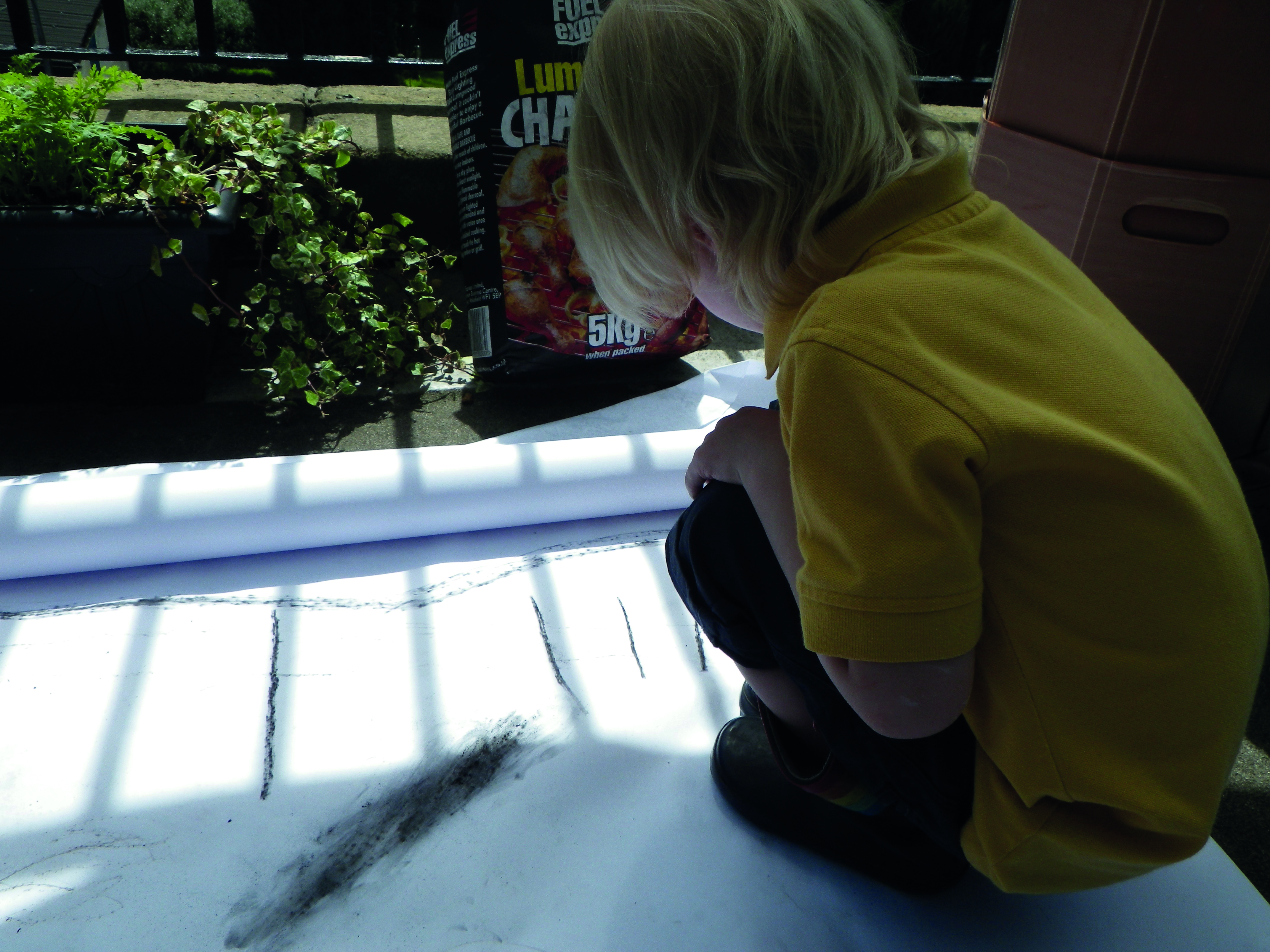
As with Maximus, the educator had a good understanding of Ella’s interests and current development. Ella was very skilful with construction, and her ability to create large, complex models indicated good gross motor skillsand an exceptional awareness and understanding of shape and space. She was also beginning to develop the language to talk about her models and the confidence to engage with her peers. She preferred to stay inside.
The educator continued to observe, sometimes smiling at Ella when they made eye contact. This gentle, respectful response gave Ella the space to continue her thinking. Rather than do the same as her friends, she very carefully drew on paper lines that looked like shadow lines from the railings.
The educator joined her. ‘Lines,’ said Ella. ‘Yes, straight lines,’ replied the educator, modelling language. They then explored ideasabout her marks and the railings, with the educator again modelling language.
Other children became involved and conversations about shadows, light and mark-making developed, facilitated by the educator who continued to comment, listen, gesture, remind and wonder.
By giving Ella the time to see, think and judge, the educator was able to support Ella’s language development through her own interests and to encourage her to express herself creatively.
Outcomes for Ella
- The space, time and response afforded to Ella allowed learning to take place uninterrupted. Ella was able to plan her own response (to draw the shadow lines), which in turn led to her handling mark-making.
- The educator introduced new vocabulary.
- As the wider group became involved, Ella was able to develop her personal, social and emotional skills.
- Following this and subsequent learning, Ella began to play outdoors more frequently, expanding the possibilities for deepening understanding in all areas of learning.
Outcomes for all
- The interest generated by Ella’s learning continued over several weeks, leading to many opportunities to develop all areas of learning.
- Seeing educators regularly observing their peers’ play helps children to feel valued and creates a caring, equal, reflective environment.
Points for reflection
- The outcomes would have been very different had the educator assumed she knew Ella’s intentions, or had a specific learning outcome in mind. The opportunity for Ella to think, remember and judge would have been inhibited, as would the opportunity for her to develop her creativity, confidence and genuine interest.
- The presence and quiet interest of the adult are powerful tools in supporting a child’s thinking and engagement with their environment. A child feels secure and an adult’s continued, respectful, gentle responses over time will allow cognition and creativity to develop.
- Think carefully before asking a question. Ask yourself why you are asking it. Children need time to think, to formulate their own questions and to make their own connections. Even if the thinking is not always verbalised by the child, the complex learning processes are happening. It is sometimes best not to verbalise what you think is happening, as Ella’s story demonstrates.
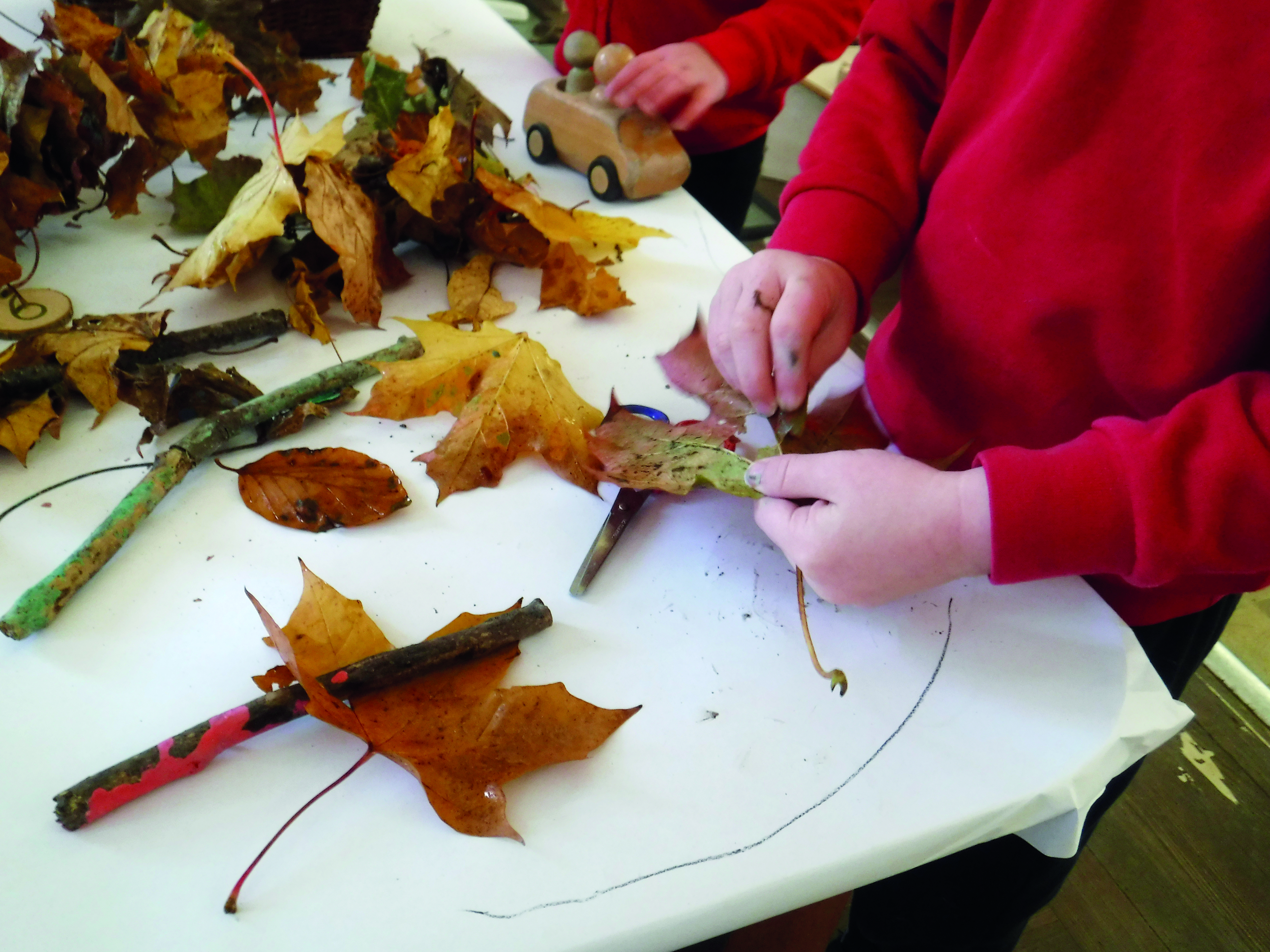
THE LEARNING ENVIRONMENT
The Responding to Process approach also has implications for how we plan and resource the learning environment.
As Maximus and Ella’s stories illustrate, found, natural objects, a calm space and a collaborative, co-operative environment all help to provide the opportunities for children to develop important cognitive and physical processes at their own pace.
To give children time to think, remember, look at things in multiple ways, use language, be creative, and develop their own interests and the confidence to pursue them, then it is vital that we create an environment that actively triggers the possibility of these things happening.
Open-ended resources and natural materials lend themselves perfectly to this aim. And the more open-ended the spaces and resources, the better. Of course, there are other essential aspects to include such as books, construction, clay, tools, structures and terrain that provide physical challenge. But when considering the environment and resources, good organisation, aesthetics and quantity are also important considerations.
Clear the clutter
Children need to know where they can find things such as tools and mark-making equipment and where to return them to safely. This supports the development of their working memory, self-regulation, independence and confidence, freeing them up to undertake new challenges and to expand and deepen their learning.
If the environment is cluttered, it becomes difficult to navigate, to keep organised (even if the resources are natural or open ended) and for these processes to develop.
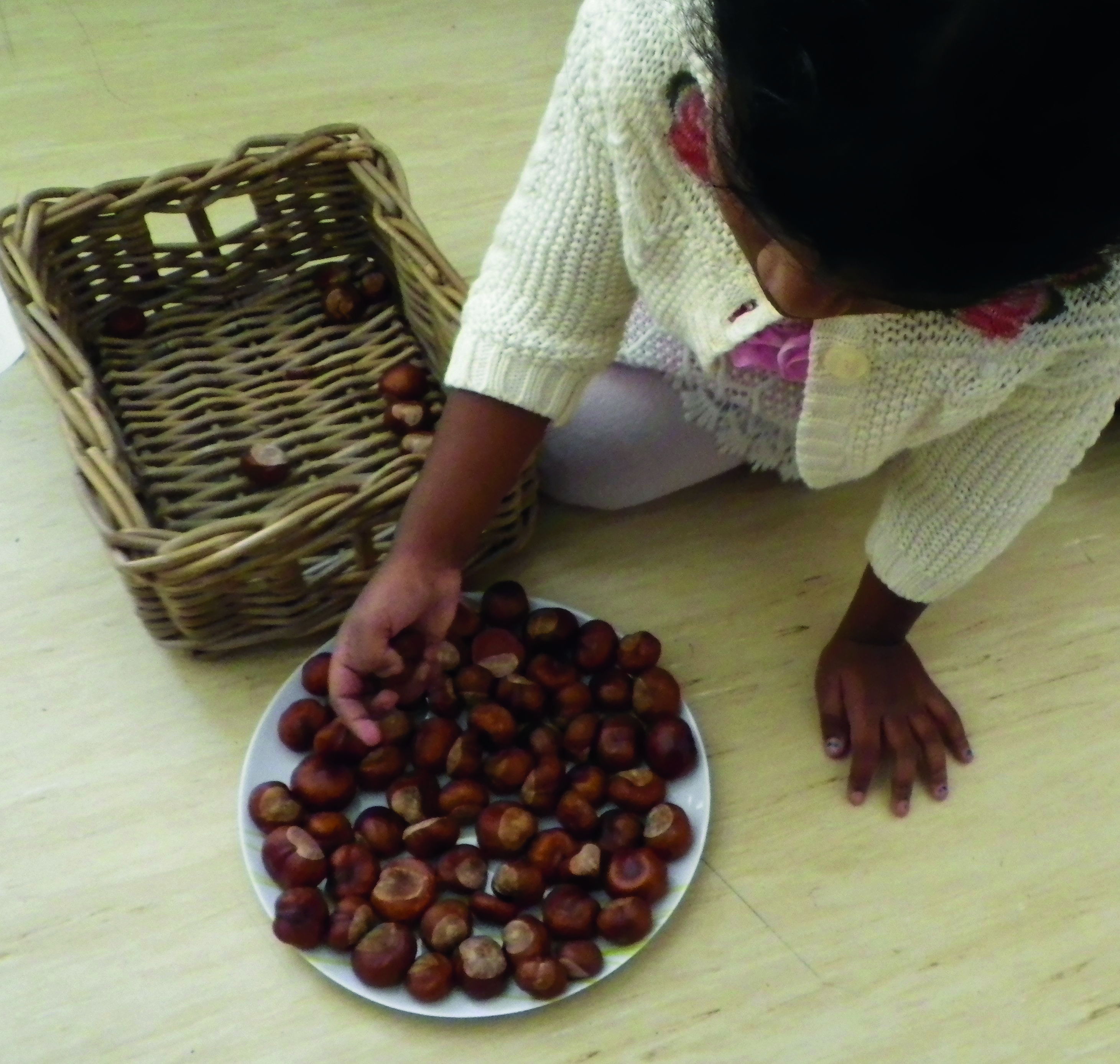
IN CONCLUSION
The processes that are happening in our brains and bodies are complex and complicated. For a developing infant, they are also fragile, as they continue to form and strengthen. As early years educators, it is crucial that we are gentle and sensitive in our responses to the children in our care, as these brain connections are forming and physical skills are growing.
If we all remember, and prioritise, these, then the early years profession can become more thoughtful and supportive – and emerge from the current crisis stronger, braver and more effective than ever before.
Responding to Process: post-Covid
With family experiences of the Covid-19 pandemic ranging from hugely positive to devastatingly life-changing, the Responding to Process approach has never been more important and potentially powerful.
Talk of children ‘being behind’ is concerning. It implies that if educators know what children should be able to do, then they should plan to make it happen quickly. The result is a focus on narrow academic outcomes dictated by some idea of ‘catching up’.
If, instead, we simply accept that each child’s cognitive and physical processes will have been impacted differently, then we will be able to respond appropriately.
Practice points to consider
- Investigate stories that allow children to explore worries and concerns.
- Many children will not have had the opportunity to be outdoors; make this a priority for your setting.
- Rotate your open-ended and natural resources and soft items such as teddy bears every 72 hours rather than replace them with plastic if you are concerned about transmission of the virus.
- Focus on attachment and relationships.
See ‘On the bright side’, EYFS best practice in schools, pages 30-33 – developing a ‘recovery’ curriculum
Alison Whelan is a lead teacher at the Federation of Darlington Nursery Schools. For further information, contact:alison.whelan@darlingtonnurseryschools.org.uk









